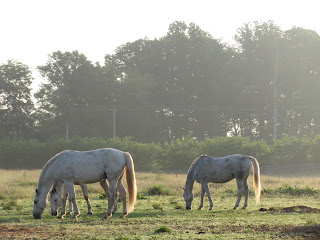I want to start this post off by saying that Melissa and I are privileged to work with a group of great horse owners. Every one of the folks who send an animal to us have gone way above and beyond "normal" care of their horses, and have done their very best to provide exemplary care for their creatures. It is our sincere wish that each horse in our care could live a long, full life and pass peacefully with his friends around him like Ivan did in March. Although he went sooner than we would have liked, in truth Ivan had a storybook ending.
Unfortunately we don't live in a static world. In reality, sometimes a horse's situation changes. Chronic conditions worsen. Quality of life factors come into play. And horse's aren't the only one who have to face changing situations. Sometimes their owner's face devastating, life changing or life ending events, and sometimes through no fault of their own situations arise whereby owners can no longer take care of their horses and pets. It's easy and politically correct to castigate pet and horse owners for not thinking these sorts of things through, but it's our opinion that he who lives in glass houses ought not to throw stones. How secure is your future ? Have you got a "disaster" plan in place for your pets ? If you get sick with a chronic, debilitating illness, lose your income, are forced to declare bankruptcy, or die an untimely death what plans do you have in place for your horses and pets ? And if you think these sorts of things can't happen to you, I'd say it's time to get your head out of the clouds and think again because they can happen to ANY of us. Horses are a luxury item and even by luxury item standards they can be extremely expensive to buy and maintain. The real bills have only begun once the purchase price has been paid.
I'd say that the general consensus is that most people believe that rehoming their pets or horses would be a better end than humanely euthanizing them. At one time I believed that myself and in many cases I still do. But the other side of that coin is that you lose control of what happens to your pet or horse once it leaves your care. A percentage of them wind up living in such hellish situations that there is no question that an early death would have been preferable to continued life. It's also true that most animals in bad situations die in them. As much as I'd love to believe otherwise, most animals in bad situations are never rescued. A horse that can still be ridden regularly can probably find a good long term home. A pasture sound horse that will forever need a companion home only is completely different.
Here are some hard questions that we've had to think about with our own pets and horses.
1. What would we do with our pets and horses in the event our financial or medical situation no longer allowed us to care for them properly ?
2. If we had to choose between quality of life and quantity of life for our pets, which is the better option ? This can be a hard question to answer as there are a lot of gray areas in this discussion.
3. Is euthanasia a better and more dignified end than giving our pets and horses away ? Another question that covers a lot of gray areas.
4. At what point have we financially done enough to ensure the best end possible for our creatures and at what point do we activate our disaster plans ?
These are hard questions and even though we've thought about them I want to be forthright and state that there are no easy or even correct answers here. In our case it depends on the horse, the pet and situation as to what the right answer is. The only thing I'm sure of is that waiting till the last possible minute when you're entire life is in crisis to decide these things is definitely not the right answer for either you or your critters.
__________________________________________
Lighty, Alex and Darby

Tiny and Toledo grooming
Romeo in the morning fog
Silver, George and Gus in the morning sun
Thomas and Hemi
Snappy and Lightening
Wiz and Dutch grooming
Grand and Elfin
Baby, Trigger and Apollo



















































